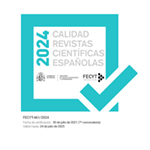‘Et vocavit nomen eius Mariam’. Aproximación iconográfica al Nacimiento de María en la pintura gótica española
Abstract
Al margen del entrañable sesgo anecdótico que, a primera vista, parece caracterizarlo, el tema iconográfico del Nacimiento de la Virgen María, de gran popularidad en el arte cristiano bizantino y europeo durante la Edad Media, puede y debe ser interpretado conforme a una dimensión de mayor profundidad doctrinal. Fundándose en una serie de citas de prestigiosos Padres de la Iglesia y teólogos medievales, el presente artículo intenta poner en luz cuatro importantes significados dogmáticos subyacentes en dicho motivo iconográfico: el nacimiento de María significa, al propio tiempo, el alumbramiento de una criatura perfecta e inmaculada, el preanuncio de su virginal maternidad divina, la proclamación profética de la redención de la Humanidad y la sugerencia metáforica de la “fuente sellada” de la que brota el “agua de la vida”. Esa triple lectura hermenéutica la hemos aplicado aquí a un conjunto de pinturas góticas españolas que ilustran a la perfección este asunto.











